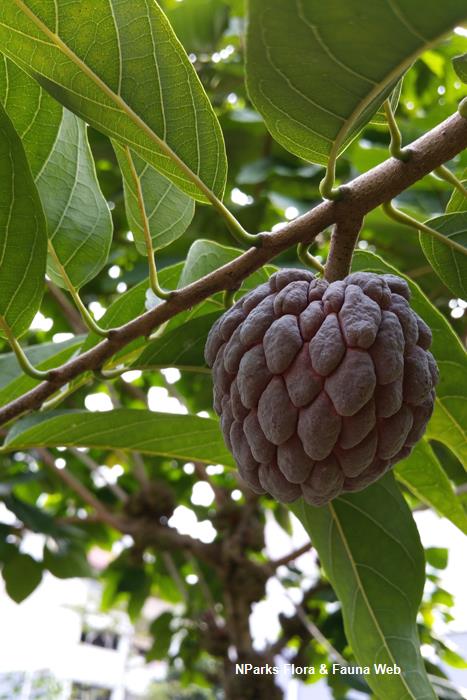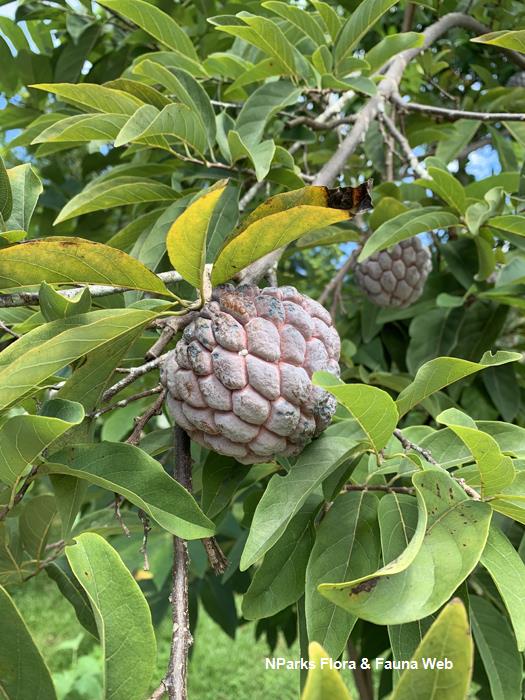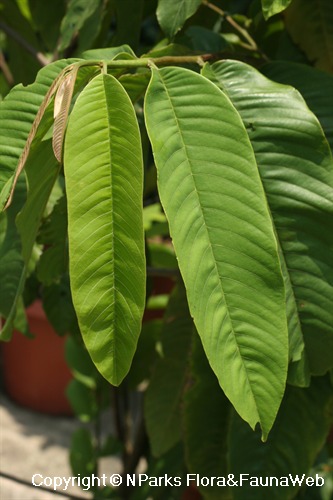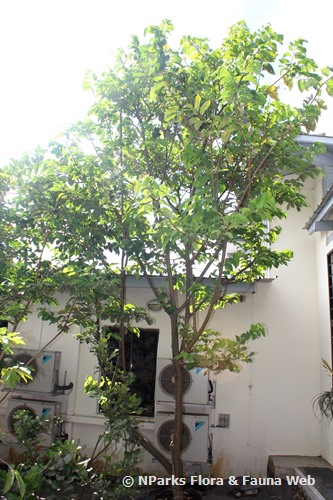
Back
Annona squamosa L.
| Family Name: | Annonaceae |
| Common Name: | Custard Apple, Sugar Apple, Sweetsop, Buah Nona, Seri Kaya, Anona, Nona, Bullock's Heart, 番荔枝 |
Annona squamosa, also known as Custard Apple, is a small tree with fragrant pendulous flowers and round-ish shaped fruit with a knobby surface. The fruit has whiteish pulp that is sweet-tasting and popular in local markets.
Name
Classifications and Characteristics
| Plant Division | Angiosperms (Flowering Seed Plants) (Dicotyledon) |
|---|---|
| Plant Growth Form | Tree (Small (6m-15m), Shrubby (1m-5m)) |
| Lifespan (in Singapore) | Perennial |
| Mode of Nutrition | Autotrophic |
| Plant Shape | Irregular, Open |
| Maximum Height | 3 m to 6 m |
Biogeography
| Native Distribution | Caribbean, Central America & Northeastern S. America |
|---|---|
| Native Habitat | Terrestrial |
| Preferred Climate Zone | Tropical |
| Local Conservation Status | Non-native (Horticultural / Cultivated Only) |
Description and Ethnobotany
| Growth Form | Small tree with an open, irregular crown. |
|---|---|
| Foliage | Leaves are elliptic to oblong with rounded to acute apex (5-15 cm long, 2 - 5 cm wide). Leaves are alternate with entire leaf margins. |
| Flowers | Fragrant yellowish green flowers hang downwards either singly or in groups of 2 - 4. Each oblong flower has 3 elongated outer petals and 3 inconspicuous inner petals (2.5 - 4 cm long). |
| Fruit | Fruit are usually round with a knobby surface. The sweet and juicy flesh occurs in elongated segments, each surrounding a brown to black, oblong seed (1 cm long). Each fruit has 20 - 40 seeds. |
| Others - Plant Morphology | Habitat: Widely cultivated in the tropics for its fruit. |
| Cultivation | This species grows well on a variety of soil types that have good drainage. Apply a 3-10-10 NPK fertilizer to maximize fruit production. Propagate by seed, grafting or budding. It is most commonly propagated by seed. For maximum germination, remove the seeds from the flesh and let dry for one week before sowing. Propagation by grafting may yield high quality fruit in a shorter time period than by seed. It is susceptible to seed borers (Bephratelloides cubensis, Bephratelloides maculicollis, Bephratelloides ruficollis, Bephratelloides paraguayensis), scale insects (Philephedra sp.), beetles, mealybugs and fungal diseases (Colletotrichum annonicola, Glomerella cingulata). |
| Etymology | The genus "Annona" is the Latin American name for the harvest goddess. The species epithet "squamosa" is derived from the Latin word for scale or scale-like. The reference is to the immature fruit's scaly appearance. |
| Ethnobotanical Uses | Edible Plant Parts : Edible Fruits Food (Herb or Spice) (Fruit or Vegetable) Others: Food: The fruit is consumed raw. It is especially popular in Brazil and India. In Malaya, the fruit is added to milk and ice cream. Medicine: Bark extracts contain compounds that protect against cancer (Suresh et al. 2006). In many parts of tropical America, a leaf decoction is used to treat colds and digestive / urinary ailments. Caution: Seeds contain toxic chemicals. A solution of ground seeds mixed with water may cause blindness upon contact with the eyes. |
Landscaping Features
| Thematic Landscaping | Economic Garden |
|---|
Fauna, Pollination and Dispersal
| Fauna Pollination Dispersal Associated Fauna | Bird-Attracting, Butterfly Host Plant |
|---|---|
| Pollination Method(s) | Biotic (Fauna) (Insects (Ant, Beetle, Fly, Thrip, Wasp)) |
| Seed or Spore Dispersal | Biotic (Fauna) |
Plant Care and Propagation
| Light Preference | Full Sun |
|---|---|
| Water Preference | Moderate Water |
| Plant Growth Rate | Moderate |
| Rootzone Tolerance | Drought Tolerant, Fertile Loamy Soils, Well-Drained Soils |
| Propagation Method | Seed, Grafting |
| Propagation Method Remarks | Budding |
| Planting Distance | 3 m |
Foliar
| Foliage Retention | Evergreen |
|---|---|
| Mature Foliage Colour(s) | Green |
| Mature Foliage Texture(s) | Smooth |
| Foliar Type | Simple / Unifoliate |
| Foliar Arrangement Along Stem | Alternate |
| Foliar Shape(s) | Non-Palm Foliage (Elliptical, Oblong) |
| Foliar Venation | Pinnate / Net |
| Foliar Margin | Entire |
| Foliar Apex - Tip | Acute, Rounded |
| Foliar Base | Acute |
| Typical Foliar Area | Notophyll ( 20.25cm2 - 45 cm2 ), Mesophyll ( 45cm2 - 182.25 cm2 ) |
| Leaf Area Index (LAI) for Green Plot Ratio | 3.0 (Tree - Intermediate Canopy) |
Non - Foliar and Storage
| Trunk Type (Non Palm) | Woody |
|---|---|
| Bark Colour(s) | Grey |
| Mature Bark Texture | Smooth |
| Root Type | Underground (Tap Root) |
Floral (Angiosperm)
| Flower Colour(s) | Green |
|---|---|
| Flower Symmetry | Radial |
| Flowering Habit | Polycarpic |
Fruit, Seed and Spore
| Mature Fruit Colour(s) | Green, Yellow / Golden |
|---|---|
| Fruit Classification | Aggregate Fruit (Syncarp) |
| Fruit Type | Fleshy Fruit |
| Mature Seed Colour(s) | Brown, Black |
| Mature Seed Texture(s) | Glossy / Shiny |
Image Repository
Others
| Master ID | 1420 |
|---|---|
| Species ID | 2713 |
| Flora Disclaimer | The information in this website has been compiled from reliable sources, such as reference works on medicinal plants. It is not a substitute for medical advice or treatment and NParks does not purport to provide any medical advice. Readers should always consult his/her physician before using or consuming a plant for medicinal purposes. |















_lowres.jpg)